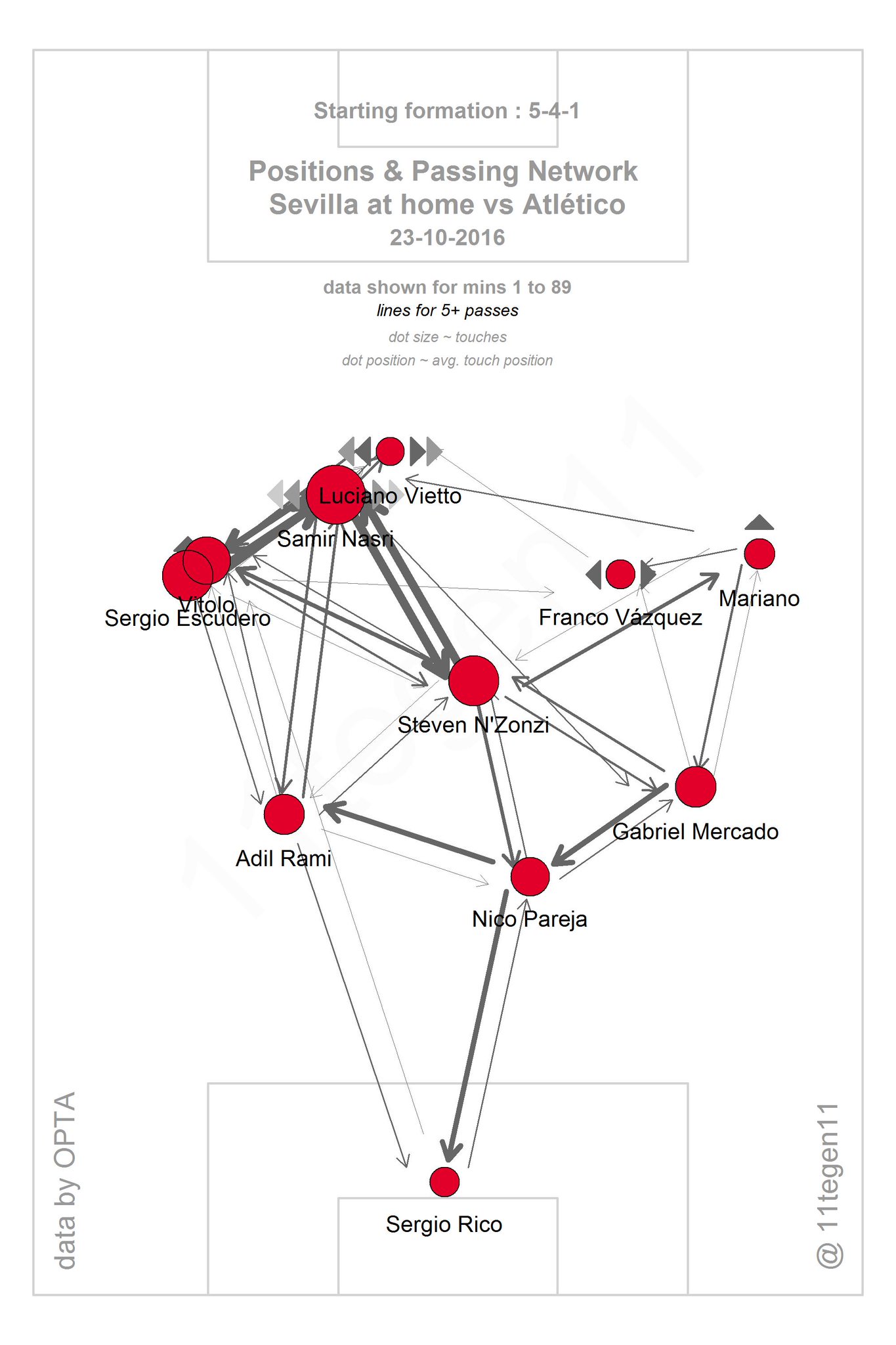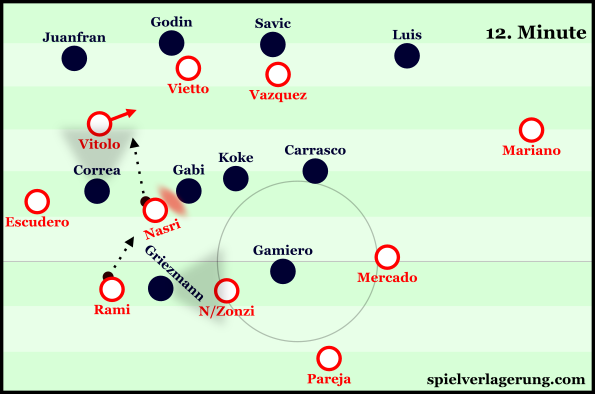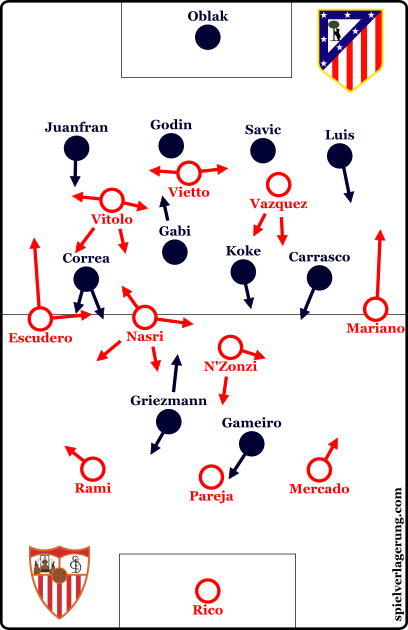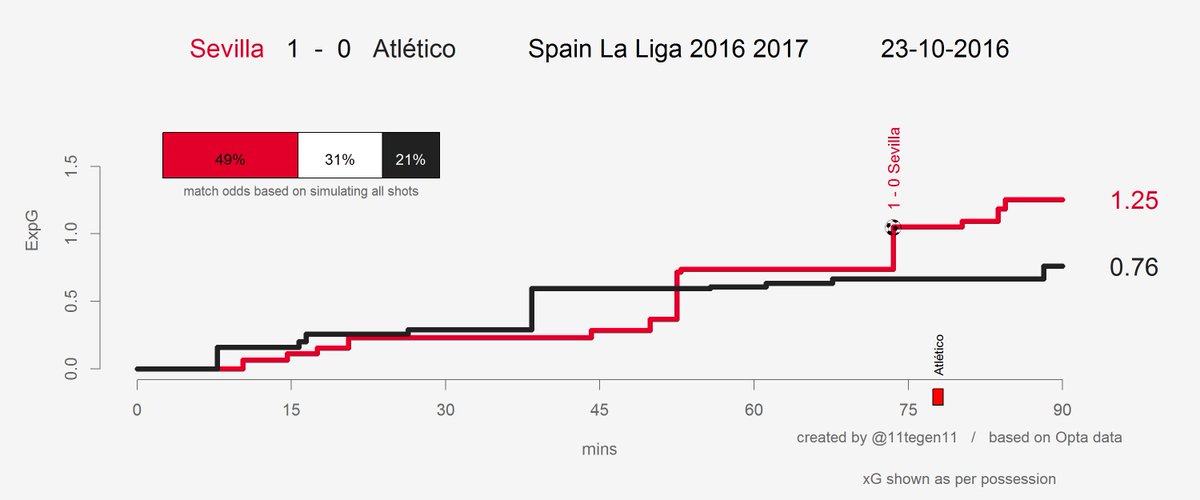Sevilla’s dynamic attacking overcomes Atlético defence
The most tactically-enticing game of the weekend-just-gone came from Spain as the best defensive system in the world travelled to stop Sampaoli’s fluid Sevilla team.Simeone’s men had started the season unbeaten away from home while no side had yet taken three points from the Ramón Sánchez Pizjuán. Every element suggested a tight and exciting match.
Atletico’s Defensive Approach
When possible, Simeone wanted his side to press high into Sevilla’s third to challenge and disrupt their build-up of possession. Whenever Sevilla’s possession started with the goalkeeper, or a trigger such as a pass backwards was made, Griezmann and Gamiero took the initiative to advance their defensive position, followed closely by the four midfielders.
In their usual manner, Atléti pressed with a clear man-to-man approach when defending within Sevilla’s own third. The two strikers would generally occupy the two relevant players of the Sevilla three-chain, whilst the ball-far winger would occupy the ball-far centre-back to try and challenge any switches.
Koke would often move slightly higher to sustain defensive access on N’Zonzi, whilst the more flexible positioning of Nasri was tracked by different players depending on the Frenchman’s activity. If the Frenchman dropped to the left side of his team’s defensive line, it would be Correa who picked him up. Whereas in the case he took on a central position, it would often be Gabi, or Atleti would simply cover the spaces around him instead.
However, such is the variability of Sevilla’s shape that there were few consistent patterns to Atlético’s pressing structure too. The tasks and orientations of the forwards often varied between possessions as Simeone’s side constantly reacted to the organisation of the opponents. The man-orientations largely ceased when Atléti dropped back into their 4-4-2(-0) mid-block, emphasising instead on their position-oriented scheme with intense shifts to maintain compactness and access.
Sevilla Possession Game feat. Nasri’s Dynamic Role

Sevilla’s pass-map of 11tegen11. Note Nasri’s high-up activity, their left-sided focus and the link between Vitolo and Escudero.
Against Atletico’s mid-block, Sevilla took a patient approach to their build-up. They were rather selective in deciding when to progress the ball into the midfield, which they did with some verticality in their fast combinations. Before this was possible however, they had to find the passing lanes to use. Across a wide back three they would quickly circulate the ball side-to-side, forcing Atléti to shift with the small possibility that a lane will be left open in doing so.
Samir Nasri and Steven N’Zonzi were key midfielders during this phase of play. The French pivot took on a fairly static positioning (in comparison to his teammates) and stayed fairly central on the second line of players. He was generally the deepest midfielder and could offer as a passing option behind Atlético’s two strikers in their first line of pressing but otherwise could fill-in any gaps within Sevilla’s three-chain at the back. Towards the left, Nasri was far more dynamic in his role and could appear in a number of different positions. A common pattern though was for him to drop into the left-back position when Escudero moved up.
Sevilla’s overall structure resembled an extremely fluid and variable 3-4-3 structure with a number of permutations. Nasri was a common instigator of these shape-changes through his movements, whilst Vitolo was another who was rather active in his positioning off of the ball. When applied in the manner of Sampaoli, such a shape is adherent to creating a large number of triangles, an important facilitator of their fast combinations and vertical play.
With Nasri being the central figure of Sevilla’s system, it was unsurprising to see a large number of their attacks take place down the left side of their shape. Vietto often moved across into the left half-space while Vitolo vacated the area by dropping deeper or further towards the touchline. Escudero’s movement was variable for a wing-back and could sometimes come inside (usually rotating with Vitolo). With each player being rather fluid and active in their movements, Sevilla were able to generate a number of harmoniously-dynamic triangles which could serve as the structure through which the passes were combined.
Considering the at-times seemingly random nature of Nasri’s positioning and movements, his role in Sevilla’s game model was particularly interesting. As they were constructing their possession, the Frenchman was rather ball-oriented and would drop frequently to engage in their deep ball circulation. In doing so, it was sometimes to overload Atlético’s first line of pressing, but mainly just to keep Nasri an active force in their movement of the ball. He saw the most touches out of the XI and could use his playmaking qualities to advance the ball, often initiating the fast combinations involving Vitolo and co.
While he was largely moving towards the ball, there were some instances where Nasri would in fact do the opposite. Primarily during deeper possession, he would drift away to the ball-far side of the pitch, disengaged from the play. In such moments, he was still influential but instead as an option to switch the play, where he could then create an attack in space with usually the ball-far wing-back. A technically-strong player such as Nasri is useful in these situations to cleanly control the difficult pass, which helps to start the attack at a high pace and better exploit any spaces opened by the stretching pass.
When Sevilla had possession of the ball in higher areas, Nasri’s role was more based around the retention of the ball and penetration through their fast combinations. He complemented the structure well through the left-hand side of the pitch, forming important connections between players which were necessary for Sevilla’s attacking style and for breaking through Atléti’s tight midfield.
His movement often seemed improvised to suit the structure best according to the scene which would, to some extent, explain the variability of his movements. The enhanced number of passing options lead to Atléti having a greater challenge in establishing effective defensive access both in their midfield pressing as well as both deeper and higher. Such collective pressing-resistance was important in the moments where Sevilla looked to play through an Atléti block which is known for it’s great intensity when pressing to stop the opponents from reaching behind the midfield.
From more of an attacking point-of-view, Nasri combined well in these moments to play teammates through into open space. He often played discrete and clever touches which would escape pressure and find open gaps as opposed to more extravagant, yet less effective long through-balls. Nasri’s free positioning gave him the capacity to surprise the visitors at times, too, as he would suddenly appear in unusual positions for some attacks, often on the other side of the pitch or closer to the left touchline, which would help to disorient any midfield pressing.
Perhaps the best example of this came early in the second half, where he received the ball on the turn to beat his man, engaged in a 4-pass combination diagonally through the middle of Atléti’s block before faking a shot to create space on his right for the real shot which hit the outside of the post.
Atlético Struggle against Pressure
Atlético’s possession game has continuously developed under Simeone’s reign and this season it seems to be taking it’s biggest leap yet. Carrasco and Correa have been integrated into key members of the side and they’re no longer just a world class defensive team, highlighted in the seven they put past Granada last weekend. Yet against Sevilla, their attacking threat was much less evident despite Sampaoli’s side not being perfect out of possession.
When Sevilla didn’t have the ball, they looked to get it back as soon as possible in typical Sampaoli style. Staying true to his Bielsa-influenced ideology, they were extremely man-oriented in doing so, going man-for-man in many situations of Atlético build-up. This created some weak moments for Atléti in the early stages of the game. The pressure on both Gabi and Koke often isolated them during their construction of possession, and Godin turned the ball over through indirect long balls in reply. Space did open up behind N’Zonzi, but Atletico’s centre-backs were rarely able to access these areas accurately due to the pressure of Sevilla and their own personal limitations.
The main bulk of dangerous situations created by Atlético were mainly from their defensive pressure forcing turnovers or creating through counterpressing moments on long balls, and they didn’t create much from developed attacks of their own accord. Pressing in Sevilla’s build-up forced a number of turnovers within the hosts’ half yet didn’t amount to many dangerous shots (usually through an underloaded attack given the circumstances). This began to change slightly around the 20th minute as Atléti were able to break through the pressure, mainly by exploiting the man-to-man focus of their opponents.
It seemed as though Simeone had instructed Griezmann to start making more dropping movements deeper into the midfield, and in doing so he’d create central overloads whilst Nasri and N’Zonzi were oriented more towards Gabi and Koke. This allowed Atlético to generate a couple of vertical attacks in the first half, wherein Griezmann would directly receive the ball to then drive the attack forward between their four forwards. Counter-attacking was also an option to create threatening moments, and the French striker was once again influential as he commonly received the ball early (with a deep starting position due to his defensive work) as he drove the ball forward at the centre of these fast breaks.
Whilst their attack wasn’t completely devoid of hope, these opportunities didn’t create a very strong threat on Rico’s goal and it got worse after the half-time break.
Sevilla Seize Upper-Hand after Half-Time
Sampaoli’s side started the game stronger after the interval, and were able to create a couple of dangerous chances within the first 10 minutes. Their fast combinations, and the brilliance of Nasri, worked to open up the visitors’ midfield and seemingly inspired Simeone to quickly make a change which saw Tiago replace Carrasco, moving Koke into a wider position.
This change in profile could’ve hypothetically strengthened the midfield, with a more defensive-minded player in central midfield and on the right – where their hosts had targeted in the opening 45.. Yet Sevilla’s impressive play continued to threaten, and it resulted in a yellow for Koke after he pulled back on Vitolo who was advancing through the left half-space. Nasri continued to be impressive and the key figure in this area of the match, and he contributed to the increasingly-dynamic structure down the left side of the pitch.
Despite their left-sided focus and intricate possession game, the goal came in completely unrelated circumstances. It was in fact Steven N’Zonzi who was the one to beat Oblak, after receiving the ball from a throw-in within his own half to then burst through the best defence in the world and run onto the end of a Luciano Vietto chipped through-ball. Okay then. Their problems were then added to by Koke’s dismissal just minutes after. The work-rate of Atléti and Simeone’s adjustments were not enough to give them a way back into the game, and the home side became the first team to topple Atléti on the road.
Conclusion
While a draw may have been a fair result for either side, Sevilla were the ones deserving of all three points if anything. Samir Nasri was the centre-piece of an impressive attacking game which showed strong dynamism and flexibility in its structure. Their pressing stunted an Atléti attack which has otherwise been excellent this season though Simeone will be disappointed with the overall performance of his side regardless of the opposition.








1 Kommentar Alle anzeigen
Alex October 27, 2016 um 9:26 pm
You lads are simply world class in your analysis. It beats all why your tactical pieces do not draw in at least 300+ comments. I can comfortably say that since 2014 when I started following this site, my füssball knowledge has grown by 200%. We appreciate you- best tactical analysis site in the world.